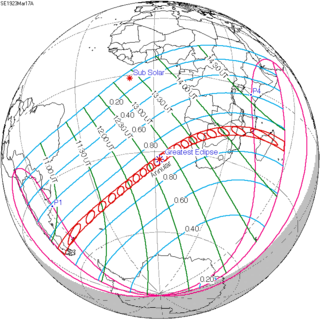| Solar eclipse of March 17, 1923 | |
|---|---|
| Type of eclipse | |
| Nature | Annular |
| Gamma | −0.5438 |
| Magnitude | 0.931 |
| Maximum eclipse | |
| Duration | 471 s (7 min 51 s) |
| Coordinates | 33°00′S 2°24′E / 33°S 2.4°E |
| Max. width of band | 305 km (190 mi) |
| Times (UTC) | |
| Greatest eclipse | 12:44:58 |
| References | |
| Saros | 138 (26 of 70) |
| Catalog # (SE5000) | 9334 |
An annular solar eclipse occurred at the Moon's descending node of orbit on Saturday, March 17, 1923,[1] with a magnitude of 0.931. A solar eclipse occurs when the Moon passes between Earth and the Sun, thereby totally or partly obscuring the image of the Sun for a viewer on Earth. An annular solar eclipse occurs when the Moon's apparent diameter is smaller than the Sun's, blocking most of the Sun's light and causing the Sun to look like an annulus (ring). An annular eclipse appears as a partial eclipse over a region of the Earth thousands of kilometres wide. Occurring about 1.7 days before apogee (on March 19, 1923, at 20:30 UTC), the Moon's apparent diameter was smaller.[2]
Annularity was visible from Chile, Argentina, Falkland Islands including capital Stanley, Gough Island in Tristan da Cunha, South West Africa (today's Namibia), Bechuanaland Protectorate (today's Botswana, Southern Rhodesia (today's Zimbabwe) including capital Salisbury, Portuguese Mozambique (today's Mozambique), Nyasaland (today's Malawi), French Madagascar (the part now belonging to Madagascar, and the Islands of Juan de Nova and Tromelin). A partial eclipse was visible for parts of southern South America, Southern Africa, Central Africa, and Antarctica.
- ^ "March 17, 1923 Annular Solar Eclipse". timeanddate. Retrieved 2 August 2024.
- ^ "Moon Distances for London, United Kingdom, England". timeanddate. Retrieved 2 August 2024.
